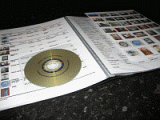Antique Porcelain Restoration, China Repair, Glass, Ceramics & Plaster
The BLUE TONGUE STUDIO
CARING FOR RESTORED CERAMIC OBJECTS
Once an object has been professionally restored, it is in the owners best interest to pay special attention to how the object is cared for. Questions often arise such as 'How do I clean the object?' & 'What is the best way to display it?' Some of the methods discussed in caring for restored ceramic objects will also be useful for owners of non-restored objects and those artists in the area of china painting.
Unlike other restoration arts, to repair a ceramic object involves using a different medium from the original. One reason for this being that ceramic shrinks when fired. Thus most ceramic objects are repaired using mediums such as epoxy, acrylic, cellulose & polyester plus various cleaning agents. As ceramic bodies can be porous to non-porous there is a large possibility of reaction to processes and materials used in the restoration. It is the art of the restorer to know what is compatible with what. Once the restoration is complete though care still needs to be taken due to the variable of the restoration process.
All objects once restored are for Ornamental & Display purposes ONLY, due to restoration materials being a health hazard when in contact with food and drink. If anyone is to tell you different ask them for the 'food friendly' material they have used in the restoration.
Handling - Special care needs to be taken when handling a restored object. Never attempt to lift the object by the restored area, i.e. handle. The restored area should be touched as little as possible. White cloth gloves can be used to reduce the grease from hands which may damage the restoration surface.
Cleaning - It is best to store the restored object in a clean environment i.e. display case. Where this is not possible the object will over time collect surface dust and require cleaning. Cleaning should be either a dry or moist cloth depending on the dirt being removed. Try not to use excessive amounts of water as this may damage the restoration surface directly or soak into the ceramic body if porous.
Contact With Foodstuffs - Under no circumstances should a restored object come into contact with foodstuffs. Reasons for this are many, the fact that one may risk poisoning, the restoration is at risk of damage due to foodstuff reaction, i.e. acidity, the abrasive action of cutlery, etc. and the temperatures created by the act of washing.
Lighting - A restored object needs to be kept out of direct sunlight. The sunlight can age the restoration i.e. turn it yellow. There will be further problems if the object is allowed to get hot in the sunlight. Keeping the object out of direct sunlight does not mean that it should be stored in a cardboard box away from view either, as research by various bodies has shown that a dark environment can age the restoration as well. This has been the case from tests that have been carried out at the studio. In most cases it is the UV in the sunlight that is the prime reason for the chance of any yellowing of the restoration, bearing this in mind florescent lighting does emit a certain amount of UV i.e. the purple light often shown at the end of the tube when warn.
Temperature / Humidity - Where possible a constant temperature and humidity level create a good environment. Using a display case can create a fairly constant humidity level. The addition of silica gel packs will allow the humidity to be kept to a minimum. An even better solution for where the environment is humid would be a dehumidifier. A high humidity level can create problems for objects with non-stainless steel parts and restored objects with water based restorations. Where the display case is lit internally do not allow the light source to become a direct heat source.
Packing - Where an object is packed make sure that a soft material such as plain white tissue paper is used especially over the restored area. If the object can be packed with the restored area not in contact with any medium, more the better.
What Not To Do - A restored object should never be placed in any kind of cooking or mechanical cleaning device, oven, microwave or dishwasher. Damage WILL result to the restored area.
Remember if you have made the investment to have the object restored then to keep it looking good TAKE CARE of it.
This article on 'Caring For Restored Ceramic Objects' was written by Andrew Goodfellow a restorer of The Blue Tongue Studio - Antique Porcelain & China Restoration Studio based in NSW, Australia.
For more information visit http://bluetonguestudio.tripod.com ________________________________________________________________________
If you would like to use the above article on your website please email us reference Article# ObjectCare
Home | Studio | Services | Conservation | Policies | Gallery
Contact Us | Birks Rawlins | Goodfellow
Object Care |
In The Studio
Art By
Andy Goodfellow |
Links
The Blue Tongue Studio Copyright 2002-2011 Australia
This website was created by The Blue Tongue Studio
Caring For Restored Ceramic Objects
 Are Your Valuables & Collections Documented For Loss Through Disaster Or Theft? Learn More By Visiting The Global Inventory Information Network Helping The World Take Inventory & Preparing Homes & Families For LossAussie Home Inventories Home Inventory Service - Australia |
 |
|
BOOK FOR SALE
|
Aussie Shopping Online |
Australian Rural Internet
Satellite Broadband
FAST 4Mbps
DVD / CD / Book
Collectors
Barcode Scanner
Estate & Finance
Software
Home Electricity
Savings Australia


